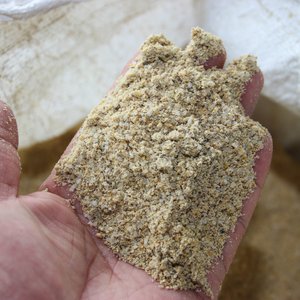FDA takes more methodic approach to safety of animal feed
Last year's recalls of pet foods drew attention to the safety of all animal feeds and particularly to the potential for contamination of ingredients.
Back in 2003, the Food and Drug Administration began an initiative to address just those concerns—though the recalls of 2007 have influenced the course of the project.
The FDA Center for Veterinary Medicine is developing a comprehensive Animal Feed Safety System to help protect the health of companion animals, production animals, and humans. A core concept of the AFSS is applying risk assessment to contaminants in ingredients for animal feed, including pet food.
George Graber, PhD, a former CVM official who organized the AFSS team and now serves as a consultant, said the FDA's existing programs to ensure safety of animal feed have focused on a few specific issues such as bovine spongiform encephalopathy and medicated feeds.
"There are gaps in the system, so the FDA is trying to modernize and strengthen it," Dr. Graber said. "The agency is expanding the universe of firms, operations, and people who are going to be impacted."
Another core AFSS concept is emphasizing preventive measures. Dr. Alfred Montgomery, CVM counterterrorism coordinator, said veterinarians should be aware of the AFSS because animal feed is a linchpin in the relationship between animal and human health.
"What threatens animal feed threatens the food chain and also companion animals that are part of the family," Dr. Montgomery said. "We need help from the veterinary community as we move forward for guidance and assistance in implementing this effort."
The latest draft of the AFSS framework includes six components that cover ingredients, contaminants, manufacturing, reporting of unsafe feed, regulatory oversight, and education and outreach.
Ingredients, contaminants
Last year, the FDA and the Association of American Feed Control Officials signed a memorandum that recognizes each organization's role in the AAFCO process for defining and listing ingredients suitable for feeds. Under the FDA Amendments Act of 2007, however, the agency will need to establish its own standards and definitions for feed ingredients.
The FDA also continues to work on methodically assessing which contaminants to limit in feed ingredients and mixed feed. Dr. Graber said the agency previously has established regulatory limits for only a handful of feed hazards, such as aflatoxin and polychlorinated biphenyls.
"But there are a number of other contaminants for which the FDA has not established any limits," Dr. Graber said. The agency has no limits for dioxins in feed, for example, and has dealt with dioxin contamination on a case-by-case basis.
Through a risk modeling process, the agency is examining dozens of feed hazards before deciding which to limit. The process involves ranking relative risks of contaminants by analyzing degrees of exposure as well as health consequences.
In the past, Dr. Graber said, producers of feed ingredients have not been subject to as much FDA oversight as manufacturers of mixed feed. Under the AFSS, the agency anticipates more extensive review of operations at ingredient processing plants.
"What the FDA wants to do is focus on those ingredients that present the greatest risk to animal and human health," Dr. Graber said.
The FDA and manufacturers of mixed feed already have taken preventive measures for some ingredients. To help prevent the spread of BSE, the FDA increased oversight of the rendering of certain animal materials for feed. Manufacturers of mixed feed routinely test corn and other crops for aflatoxin.
Manufacturing, surveillance
Regulations on good manufacturing practices are in place now primarily for medicated feeds and compliance with the BSE feed rule. As part of the AFSS, the FDA will write regulations for process controls to cover the manufacture of all feed ingredients and mixed feeds.
"Regulations would require manufacturers to ensure that what goes on in their operations is not going to introduce unsafe hazards into our general feed supply," Dr. Graber said.
The new rules would apply to commercial manufacturers as well as on-farm feeding operations. Right now, Dr. Graber said, on-farm feeding operations usually don't show up on the FDA's radar if they aren't mixing medicated feeds.
Under the 2007 FDA Amendments Act, the agency also will need to be more responsive when incidents of unsafe animal feed and human food do occur.
The agency must create an early warning and surveillance system specifically for the identification of unsafe pet food and outbreaks of illness in association with pet food. Additionally, the FDA must create a reportable food registry for all animal feed and human food. The reports will come from manufacturers and health officials.
"In spite of whatever you do, there are surprises that happen," Dr. Montgomery said. "There are emerging infectious agents, new and old toxic substances with synergistic effects, a growing global marketplace, new technology, economic incentives to cheat that spill into safety, and terrorism."
Regulatory oversight
While U.S. manufacturers are ultimately responsible for producing safe feed, regulatory oversight exists at the state and federal levels.
State feed officials probably conduct more testing collectively than the FDA does, Dr. Graber said, though the federal agency does sample ingredients and feeds. The FDA responds to complaints as well. In developing the AFSS, though, the agency is relying on risk assessment to decide where to focus sampling and facility inspections.
Dr. Graber said the AFSS meshes with activities under the broader FDA Food Protection Plan of 2007, which emphasizes risk assessment and preventive measures.
The CVM also is working with other FDA units and groups that deal in imports to improve oversight of feed distribution, importation, and counterterrorism.
Vehicles for the transport of feed receive little inspectional scrutiny, for example. Dr. Graber said the FDA Center for Food Safety and Applied Nutrition is looking into additional oversight in this area.
For imports of feed ingredients and mixed feed, Dr. Graber said, the FDA hopes to negotiate agreements with foreign governments and industry to implement process controls abroad that ensure good manufacturing practices. Additionally, the agency is working with U.S. importers to make sure the products that they import are safe.
For feed defense, Dr. Montgomery said, the AFSS team has identified contaminants that bioterrorists might add to feed or feed ingredients. The CVM developed criteria to help import inspectors focus on those feeds and feed ingredients that might be at risk for deliberate contamination.
In the big picture, Dr. Montgomery said, "You can't control for all of the hazards, but you can't sit there and do nothing, either. The Animal Feed Safety System is just one mechanism that attempts to grapple with some of these issues with animal feeds."







